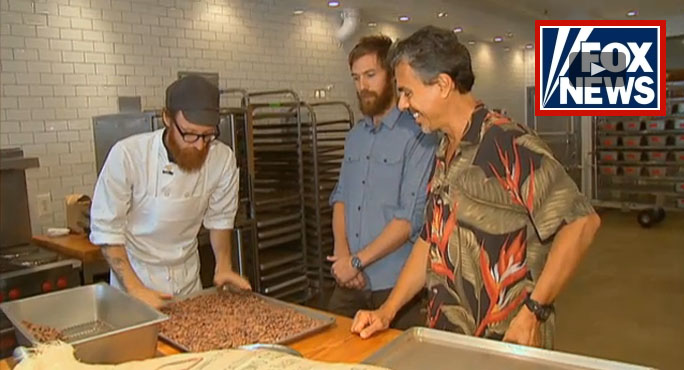Click image above to watch “From Bean to Bar: How Chocolate Is Made” on Fox News
Read more about everyone's favorite plant medicine in our special Cocoa, Food of the Gods section.
Chris Kilham, the Medicine Hunter, is known for eating some bizarre foods while on the hunt for nature's medicines, but his latest adventure led him down a much "sweeter" path.
Kilham recently visited Mast Brothers Chocolate in Brooklyn, N.Y. to see how cocoa beans from plantations around the world end up as one America's favorite guilty pleasures . . . that may not be so guilty after all.
Studies have shown that chocolate is actually good for you – it’s health benefits range from helping to protect the heart and mind, to enhancing your sex drive.
Mike and Rick Mast started making certified organic chocolate in 2007. Each week, they produce about 5,000 bars made from some of the best cocoa beans in the world.
“We’ve got beans from Madagascar, beans from Peru. . .basically our criteria is simple: We only source from the best, so we search the world over for the best cocoa beans,” said Rick Mast.
The first rule of chocolate making, as Kilham discovered, is no bad beans allowed. That means before the the beans are roasted, they have to be hand-sorted one-by-one.
“We’re not just making sure that we’re getting rid of any flat beans, any beans that are misshapen or are just not up to our standards, and we're screening them before we begin to roast,” Mike Mast said.
The beans are carefully laid out on a tray so that they roast evenly before they're put into a convection oven set around 300°F. The roasting process helps separate the bean from the husk and bring out the rich, chocolate flavor.
“We wait nine minutes. At that time, we’ll take the tray out, shake it, flip it, and put it back in – and the first step will be done,” Rick Mast said.
Kilham said the next step involves a machine, called a cracker, that looks like it was ripped from the mind of Willy Wonka himself. The beans are poured into the cracker where they are separated from the husks leaving only the cocoa nibs that are used the make chocolate.
The Mast brothers donate leftover husks to local farmers for compost, Kilham noted.
Then the nubs are ready to go under the stone grinders, where they remain for one to three days. A cocoa bean is made up of about 54 percent cocoa butter, so the Mast brothers are able to make their organic chocolate by simply grinding the beans. The only ingredient that is added during the grinding process is some organic cane sugar.
After the grinder, the chocolate is strained and put on a rack to age for about 30 days. Much like a fine wine, the aging process brings out the rich flavors in the chocolate.
"Aging chocolate is really interesting because it's what we call unstable," Rick Mast said. "As it sits here, the cocoa butters will actually start rising to the top, so to finish the chocolate, you actually have to remelt it down and put it through the tempering process which is the next stage."
Tempering is what gives chocolate its shiny look and that firm snap we all love.
“This is where we’ll put it in the molds and let it set in the refrigerator for 15-20 minutes, and then it will pop right out and be ready to be wrapped,” Mike Mast said.
Kilham had the opportunity to taste one of the Mast brothers’ Grand Cru reserve chocolate bars, with 76 percent cocoa -- which means it's chock full of health benefits.
How did it taste? Well, the only other question Kilham had was whether or not the Mast brothers could deliver a “van-load” of it to his house.


